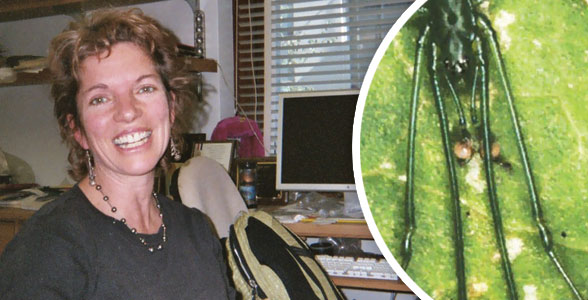The spider hung from a leafy tree branch. It was bright green, and it brandished a giant claw designed to attack the insects on which it fed. Staring at the creature through the glowing light of her headlamp, Rosemary Gillespie (Knoxville ’86) could hardly believe her eyes. There was only one spider in the world with a claw quite like that–the rarely encountered Doryonychus raptor, which had been scientifically collected only once, by an obscure British naturalist in 1901.
Unbelievable! And yet, there it was. Somehow, against enormous odds, Gillespie–today one of the world’s leading authorities on the behavior and evolution of arachnids–had managed to track down a D. raptor in the heart of a pitch-dark Hawaiian forest. But could she successfully collect this astonishing specimen and bring it back to civilization?
“I was surveying a forest for spiders on that night in 1991,” recalls the 50-year-old scientist and professor of insect biology (since 1997) at the University of California–Berkeley, “and all at once, it just dropped down on a string of silk in front of me. I was absolutely stunned. When you’ve been looking for a creature for several years as I had, it’s an extraordinary feeling to suddenly come upon it.
“That spider was just hanging there, a female, and all I had to do was scoop her up in my plastic vial. But collecting her wasn’t easy, because my hands were shaking so much. It took a lot of concentration, but when I finally got her into the vial, there was this moment of incredible euphoria.
“For a biologist who specializes in spiders, it just doesn’t get any better than that night on Kauai.”
During more than 20 years of studying spiders in habitats that range from Hawaii to French Polynesia to Fiji, the peripatetic Gillespie says she’s come to greatly admire the “beauty and elegance” of her subjects, which possess “an amazing ability” to use their silk-spinning and leaping abilities as survival weapons.
“Spiders are interesting because of the way they feed on insects and each other,” says the internationally recognized arachnophile, who has published dozens of studies of spider behavior since earning a Ph.D. at UT Knoxville. “Because of their feeding habits, they face intense competition–and the evolutionary history of many spider species can be extremely complex and challenging as a result.”
In order to better understand how some of the more than 40,000 known spider species have evolved over time, Gillespie spent nearly a decade pushing through dripping cloud forests in the Hawaiian Islands. Armed with only a miner’s headlamp (most spiders feed at night, so Gillespie’s forays were of necessity nocturnal), she tracked a particularly skilled predator–the “happy face” spider–across the vegetation-tangled summits of fog-shrouded volcanoes that few Hawaiian tourists will ever see.
While gathering data on the evolution of “long-jawed” spiders for a series of articles in such high-profile scholarly publications as Science, Gillespie enjoyed “a marvelous time out in the field”–and never once felt “the slightest fear” of her eight-legged subjects.
“I do think it’s remarkable how so many people seem to fear these little animals,” she says with a cheerful smile. “There’s usually nothing at all to be afraid of because spiders are actually quite shy and retiring.
“They aren’t interested in humans, really. They can’t eat humans, after all–they simply want to be left in peace. Even the very few poisonous species–the black widows and the brown recluses–prefer to live in seclusion, far away from people.”
Born and raised near the small Scottish enclave of Castle Douglas in the U.K., Gillespie earned a B.S. in zoology at Edinburgh University before arriving on the Knoxville campus in 1980 to study with famed UT spider authority Dr. Susan Reichert. “I’d been reading her papers on arachnid behavior for some time,” says Gillespie, who was honored by the White House with a Presidential Award for Excellence in Science, Mathematics, and Engineering Mentoring in 2005, “and I was extremely fortunate to be able to work with her as a grad student.
“It was certainly a fascinating six years,” she adds. “Susan sent me over to the Highlands Biological Station in North Carolina, and I spent weeks at a time chasing after a family of long-jawed spiders with a very interesting evolutionary history.
“A few years later, when I went to do research in Hawaii [1987], I was amazed to find the same species flourishing all over the islands, and I had a great deal of fun studying them!”
Married to University of California entomology professor George Roderick and the mother of boys aged 11 and 13, who often accompany her on spider-chasing forays into the wild, Gillespie says she “can’t get enough” of her exciting fieldwork.
“What I really like is exploring,” she explains, while leading a visitor on a brief tour of the university’s Essig Museum of Entomology, where more than 54 million bug specimens reside. “Fieldwork often requires a lot of hard hiking and crossing swollen rivers–it’s just terrific fun, if you like the outdoors.”
Then, after pointing to one of the Essig’s most popular inhabitants–a giant tarantula known as the goliath birdeater, reportedly the largest spider species in the world–she bubbled over with the enthusiasm of the born arachnophile: “Once you really get to know spiders and their habits, you realize that they’re beautiful creatures with amazing skills that have developed over millions of years.
“They’re endlessly fascinating, really, and not scary at all.”



